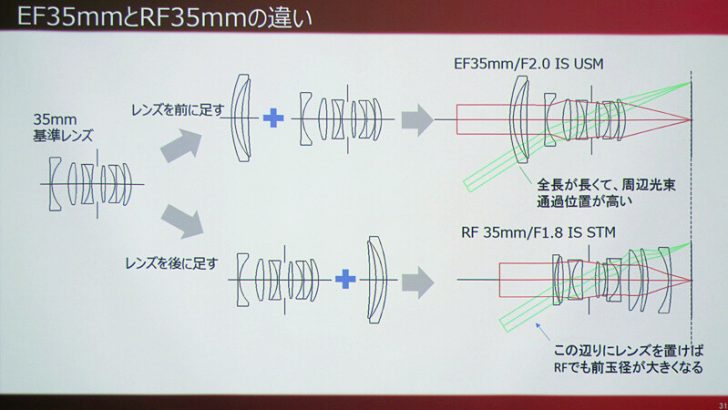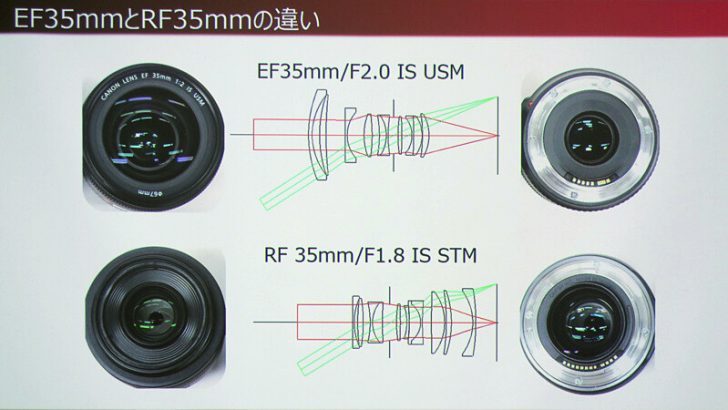DCWatch has posted an internal Canon presentation about the advantages of the RF mount's large diameter. Canon describes why they developed a new mount over using the existing EF-M mount. The large diameter of the RF mount allows for simpler and better-balanced lens design.
The RF mount allows for the larger lens elements to be near the rear of the lens and closer to the camera mount and the image sensor. This should provide better balance when larger aperture lenses are affixed to the EOS R. While this could technically have been done with the EF-M mount, it's far easier for Canon to design lenses for the RF mount.


Canon News breaks this down further, showing the differences in philosophy between Sony and Canon. Sony puts the larger lenses at the front of the lens, while Canon's RF lenses seem to put the larger ones at the rear of the lens.
Another apparent advantage of the larger diameter mount is less vignetting on the image sensor itself. Software generally handles vignetting for us now, but this should make sensor and software design a bit easier going forward.
From DCWatch (Google Translated):
According to the optical designer of Canon, it is said that the following three points are the main judgment criteria because “it is optically good” in what “beautiful” is said.
· The symmetry of the optical system is high before and after the diaphragm
· The refraction of the light is gentle
· the large ball and the small ball are lined up in good balance Read the full article


If you look at the two lenses, the pupils are quite alike, despite the different size of the front lens.
Anyway, keeping larger lenses close to the camera should also make handling the camera more comfortable, especially with smaller and lighter mirrorless.
Exactly. Please admin: change this article to stop the spread of this wider RF mount misinformation.
So the article is not so wrong after all.
actually, the diameter *IS* very important. it's a combination of lens registration distance and mount diameter that gives the flexibility.
which is why they didn't use the EF-M mount. they could use the EF-M mount, and the article states that Canon even considered it.
the larger mount diameter allows them to "flip" the elements around, and not use an element to "spread" the light across the entire sensor.
This is why when I wrote CN's article, I compared the RF lens to a similar Sony FE lens, and the differences are as Canon discussed in their presentation.
of course Canon could have "pulled a Sony" and used APS-C optimized M-mount also for FF. But it would have resulted in the same design restrictions that Sony FE lenses suffer from: lenses that are too big, too heavy, too complex and too expensive.
It was clear (to me) that Canon would not go that route. as with SLRs (EF/EF-S) they continue with 2 mounts for mirrorfree: one optimally chosen for APS-C, 1 for FF image circle.
now all we have to wait for is RF lens prices dropping to EF levels.
The size of the front element group mostly determines how much light is gathered at the edges and corners. Bigger front elements give less vignetting. It’s not entirely that simple, but that’s the gist of it.
A very short backfical distance allows smaller lens elements overall, because the rear element group still is smaller than what the front would have been. What I’m seeing with all the illustrations here, and elsewhere, is an exaggeration of the size of elements for lens designs for mirrorless. The reality isn’t so exaggerated.
What gives?
So maybe instead of huge, tapering, front heavy lenses, we get huge 'rectangular' lens bodies with all the heavy glass near the mount instead of in the front.
yes, it does.
no, it will not allow for miracles in design of longer focal lengths/tele lenses
no, they won't. Way too late. Sony and their customers now have to live with the consequences of Sony's bad decision to use their crop-sensor E-mount also for FF image circle.
Nikon however may well come up with a second, smaller mount for a mirrorfree APS-C system - if they ever make one.
no, they will not. Why should they? EOS M/EF-M is the market leading APS-C ecosystem (probably ahead now of EF-S and certainly ahead of Fujifilm C and Sony E), because it offers good capability at affordable prices in very compact gear - thanks to optimally chosen EF-M lens mount parameters. Not possible to the same degree with R mount.